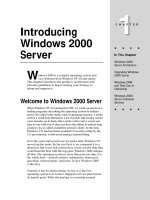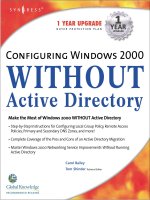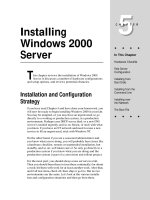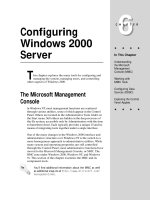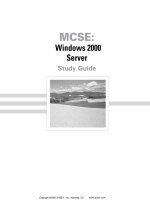Tài liệu Introducing Window 2000 Server doc
Bạn đang xem bản rút gọn của tài liệu. Xem và tải ngay bản đầy đủ của tài liệu tại đây (95.02 KB, 22 trang )
Introducing
Windows 2000
Server
W
indows 2000 is a complex operating system and
very different from Windows NT 4.0 and earlier.
This chapter introduces the product’s architecture and
provides guidelines to begin creating your strategy to
adopt and support it.
Welcome to Windows 2000 Server
When Windows NT 4.0 emerged in 1996, we wrote an article in a
leading magazine describing the operating system in military
terms. We called it the strike craft of operating systems. A strike
craft is a small boat that packs a lot of punch and usually carries
a few missiles on its back. But a strike craft is not a vessel you
take to war with you. It does not have the ability to endure long
journeys; its so-called availability period is short. At the time,
Windows 3.51 had just been awarded C2 security rating by the
U.S. government, so the naval analogy seemed fitting.
Over the years and several service packs later, Windows NT
moved up the ranks. By Service Pack 4, we compared it to a
destroyer. But it was still a down-fleet vessel, not the ship that
would lead the fleet with the top guns. Windows 2000 changes
all that. The operating system is more than just one ship; it is
the whole fleet — aircraft carriers, submarines, destroyers,
gun-ships, minesweepers, and more. In fact, Windows 2000
is the navy.
Granted, it has its shortcomings. In fact, it is the first
operating system ever to have shipped a service pack before
its launch party. While the analogy to a warship seemed
1
1
CHAPTER
✦✦✦✦
In This Chapter
Windows 2000
Server Architecture
Integrating Windows
2000 Server
Windows ZAW
and Total Cost of
Ownership
Windows 2000
Server Collateral
Services
✦✦✦✦
4667-8 ch01.f.qc 5/15/00 1:56 PM Page 3
4
Part I ✦ Windows 2000 Server Architecture
amusing to many over the years, it is more applicable today than ever before. In
the world of e-commerce and the Internet, we are all on the battlefield. This is the
world war of commerce and e-sabotage, exploding onto the networks of the world.
Over the past few decades, only the big companies could afford the big iron
mainframes from the likes of IBM and Digital Equipment Corp. Now that firepower is
in the hands of everyone with enough money to register a dot-com. We are fighting
a network war in which the competition is able to obtain weaponry and firepower
never before thought possible in computer science.
Viral warfare is surging beyond belief with thousands of computer viruses released
every month. Hackers are penetrating corporate networks all over the world.
Business people are hiring geeks to bombard their competition with datagram
attacks and denial-of-service bombs. And fraud is just around the next router. You
need an operating system that can protect you at home and away from home, at
every portal, and at every location. Today, no operating system competes with the
vastness of Windows 2000 Server.
According to McAfee, there are currently 47,000 known viruses, variants, and
Trojan horses in the world . . . “this increases by approximately 1,000 per month.”
Before we look into the weaponry and architecture that supports Windows 2000
Server, it is important to understand that it is not all guns and roses. Windows
2000 Server leaves a few oil spills here and there, and we will discuss these where
appropriate. However, it is worth mentioning here that a huge hurdle to overcome,
besides the long-winded name, is the learning curve. No version of Windows NT (in
fact, no other server operating system) is as extensive, as deep, and as complex in
many places.
While Windows 2000 Server has been created to cater to the demand for operating
systems that cost less to manage and own, realizing the benefit will be a long and
costly journey for many. Windows 2000 Server is not the only culprit; UNIX, NetWare,
and the midrange systems also have a long way to go before they can truly claim to
reduce the total cost of ownership, not only in terms of operating systems and
software, but also in terms of all technology ownership and management.
There are two ways to decide what you want to do about Windows 2000 Server. For
a start, know that all your competitors are in the same boat. Whoever takes the
plunge and adopts first will be better off down the road. You can a) ignore Windows
2000 Server for the next 6 to 12 months on the premise or misguided advice that
you should wait for the OS to ship at least two service packs, or you can b) take the
plunge now and deploy it in labs and development environments and be ready
when the inevitable “we need it now” memo arrives.
Throughout this book, we suggest the latter approach. Put the OS into controlled
development and pilot projects and deploy selective components that provide
better services than what is available under NT. You cannot learn the OS overnight,
Note
4667-8 ch01.f.qc 5/15/00 1:56 PM Page 4
5
Chapter 1 ✦ Introducing Windows 2000 Server
so it makes sense to get the evaluation copies and learn as much as you can now.
This is where much of Windows 2000 Server will be for most of 2000, in phased
implementation and development projects. After all, you have nothing to lose
except a little time.
With ongoing systems to support, Windows 2000 Server typically requires a skilled
network engineer or systems analyst to invest about six to eight months into the OS.
And even after eight months of intense study, you still can’t consider yourself an
expert. Perhaps the best way to tackle the learning curve, besides spending a lot of
money on courses where end-to-end training runs into five figures per administrator
and without the cost of absence from work during the training, is to divide up the
key service areas of the OS.
To a large extent, we have divided this book along the key service lines listed here:
✦ Windows 2000 Architecture
✦ Active Directory Services
✦ Security Services
✦ Network Services
✦ Availability Services
✦ File and Print Services
✦ Application Services
This chapter deals with Windows 2000 Architecture and introduces you to key
services that fall under the Zero Administration Windows (ZAW) initiative.
Windows 2000 Server Architecture
Making the effort to understand the architecture of an operating system is a lot like
making the effort to understand how your car runs. Without knowing the details, you
can still drive and the vehicle will get you from A to B. But when something goes
wrong, you take your car to the shop and the mechanic deals with it. He or she will
tell you that you should have changed your oil earlier, or that your tires needed
balancing, or that your spark plugs were loose. Had you known how the car operates,
you would have taken more care of it and prevented excessive wear and tear. You
could probably have serviced it yourself.
The same can be said about an operating system, although it is a lot more complex
than a car’s engine. If you understand the various components of the kernel (the
OS), the file system, and how the OS uses processors, memory, hardware, and so
on, you will be better at administering the machine.
4667-8 ch01.f.qc 5/15/00 1:56 PM Page 5
6
Part I ✦ Windows 2000 Server Architecture
Operating System Modes
Windows 2000, built on NT, is a modular, component-based operating system. All
objects in the operating system expose interfaces that other objects and processes
interact with to obtain functionality and services. These components work together
to perform specific operating system tasks.
The Windows 2000 architecture contains two major layers: user mode and kernel
mode. The modes and the various subsystems are illustrated in Figure 1-1.
The system architecture is essentially the same across Professional, Server,
Advanced Server, and Datacenter Server.
Figure 1-1: The Windows 2000 Server System architecture (simple)
User Mode
Kernel Mode--Executive Services
Win32
Subsystem
Win 32 Application
Integral
Subsystem
POSIX
Subsystem
POSIX Application
OS/2
Subsystem
OS/2 Application
I/O
Manager
File
Systems
PC
Manager
Memory
Manager
Process
Manager
PnP
Manager
Power
Manager
Window
Manager
Security
Reference
Monitor
Graphics
Device
Drivers
Executive Services
Hardware
Object Manger
Device Drivers Microkernel
Hardware Abstraction Layer (HAL)
Note
4667-8 ch01.f.qc 5/15/00 1:56 PM Page 6
7
Chapter 1 ✦ Introducing Windows 2000 Server
User Mode
The Windows 2000 user mode layer is typically an application support layer, for
both Microsoft and third-party software, consisting of both environment and integral
subsystems. It is the part of the operating system on which independent software
vendors can make operating system calls against published APIs and object-oriented
components. All applications and services are installed into the user mode layer.
Environment subsystems
The environment subsystems provide the ability to run applications that are
written for various operating systems. The environment subsystems are designed
to intercept the calls that applications make to a particular OS API, and then to
convert these calls into a format understood by Windows 2000. The converted API
calls are then passed on to the operating system components that need to deal with
requests. The return codes or returned information these applications depend on
are then converted back to a format understood by the application.
These subsystems are not new in Windows 2000, and they have been greatly
improved over the years on NT. There have been reports in some cases that
the applications will run better on Windows 2000 than they do on the operating
systems they were intended for. Many applications are also more secure in
Windows 2000. For example, Windows 2000, without affecting server stability,
terminates DOS applications that would typically crash a machine just running
DOS. Table 1-1 lists the Windows 2000 environment or application subsystems.
Table 1-1
Environment Subsystems
Environment Subsystem Purpose
Windows 2000 Win32 (32-bit) Supports Win32-based applications. This subsystem
is also responsible for 16-bit Windows and DOS
applications. All application I/O and GUI functionality
is handled here. This subsystem has been greatly
enhanced to support Terminal Services.
OS/2 Supports 16-bit OS/2 applications
(mainly Microsoft OS/2).
POSIX Supports POSIX-compliant applications
(usually UNIX).
The non-Win32 subsystems provide a basic support for non-Win32 legacy applica-
tions and no more. There is no real demand for either subsystem, and they have
4667-8 ch01.f.qc 5/15/00 1:56 PM Page 7
8
Part I ✦ Windows 2000 Server Architecture
been maintained only to run the simplest of utilities that make very direct and
POSIX- or OS/2-compliant function calls, usually in C. The POSIX subsystem, for
example, caters to the likes of UNIX utilities VI and GREP.
The POSIX subsystem is not retained as a means, for example, of advanced integra-
tion of UNIX and Windows 2000, such as running a UNIX Shell on Windows 2000. For
that level, you need to install UNIX Services. More about this later in this chapter.
There are several limitations and restrictions imposed on non-Windows applications
running on Windows 2000. This is demonstrated in the following list, which for the
most part also includes user mode, Win32-based applications:
✦ Software has no direct access to hardware. In other words, when an application
requests hard disk space, it is barred from accessing hardware for such infor-
mation. Instead, it accesses user mode objects that talk to kernel mode objects,
that talk down the operating system stack to the Hardware Abstraction Layer
(discussed shortly). The information is then passed all the way up the stack
into the interface. This processing is often known as handoff processing. The
function in the Win32 code essentially gets a return value, and developers have
no need to talk to the hardware. This is good for developers and the operating
system. APIs that check the validity of the call protect the OS, and developers
get exposed to a simple call-level interface, which typically requires a line of
code, not 10,000 lines.
✦ Software has no direct access to device drivers. The philosophy outlined
previously applies to device drivers as well. Hardware manufacturers build
the drivers for Windows 2000 that access the hardware. The drivers, too,
are prevented from going directly to the hardware, interfacing instead with
abstraction objects provided by the device driver APIs. This is discussed
later in this chapter, along with the new Windows Driver Model initiative.
✦ Software is restricted to an assigned address space in memory. This constraint
protects the operating system from rogue applications that would attempt to
access whatever memory they can. This is impossible in Windows 2000, so an
application can only screw up in the address space it is assigned.
✦ Windows 2000, like Windows NT, will use hard disk space as quasi-RAM.
Applications are oblivious to the source or type of memory; it is transparent
to them. Virtual memory is a combination of all memory in the system; it is
explained in more detail later in this chapter.
✦ The applications in the user mode subsystems run as a lower priority process
than any services or routines running in the kernel mode. This also means
that they do not get preference for access to the CPU over kernel mode
processes.
4667-8 ch01.f.qc 5/15/00 1:56 PM Page 8
9
Chapter 1 ✦ Introducing Windows 2000 Server
Integral subsystems
The integral subsystems are used to perform certain critical operating system
functions. Table 1-2 lists these services.
Table 1-2
Integral Subsystems
Integral Subsystem Purpose
Security Subsystem Performs the services related to user rights and access control
to all network and OS objects defined or abstracted in some
way in the OS. It also handles the logon requests and begins
the logon authentication process.
Server Service This service is what makes Windows 2000 a network
operating system. All network services are rooted in this
service.
Workstation Service The service is similar in purpose to the server service. It is
oriented more to user access of the network. (You can
operate and even work at a machine that has this service
disabled.)
There is little you need to manage with respect to these systems. These services
are accessible in the Service Control Manager and can be started and stopped
manually.
Kernel Mode
The Windows 2000 kernel mode is the layer that has access to system data and
hardware. It comprises several components, as illustrated in Figure 1-1.
The Windows 2000 Executive
The “Executive” is the collective noun for all executive services, and it houses
much of the I/O routines in the OS and performs the key object management,
especially security. The Executive also contains the Systems Services components
(which are accessible to both OS modes) and the internal kernel mode routines
(which are not accessible to any code running in user mode). The kernel mode
components are as follows:
✦ I/O Manager: This manages the input to and from the devices on the machine.
In particular, it includes the following services:
• File System: Translates file system requests into device-specific calls.
4667-8 ch01.f.qc 5/15/00 1:56 PM Page 9
10
Part I ✦ Windows 2000 Server Architecture
• Device Drivers: Manages the device drivers that directly access
hardware.
• Cache Manager: Buried in the I/O manager code, it manages I/O
performance by caching disk reads. It also caches write and read
requests and handles offline or background writes to the hardware.
✦ Security Reference Monitor: This component enforces security policies on
the computer.
✦ Interprocess Communication Manager (IPC): This component makes
its presence felt in many places in the OS. It is essentially responsible
for communications between client and server processes. It comprises
the Local Procedure Call (LPC) facility, which manages communications
between clients and server processes that exist on the same computer, and
the Remote Procedure Call (RPC) facility, which manages communications
between clients and servers on separate machines.
✦ Memory Manager or Virtual Memory Manager (VMM): This component
manages virtual memory. It provides a virtual address space for each process
that manifests and protects that space to maintain system integrity. It also
controls the demand for access to the hard disk for virtual RAM, which is
known as paging (see the section Windows 2000 Memory Management later
in this chapter).
✦ Process Manager: This component creates and terminates processes and
threads that are spawned by both systems services and applications.
✦ Plug and Play Manager: This component is new to Windows 2000. It provides
the Plug and Play services and communicates with the various device drivers
for configuration and services related to the hardware.
✦ Power Manager: This component controls the management of power in the
system. It works with the various power management APIs and manages
events related to power management requests.
✦ Window Manager and Graphical Device Interface (GDI): The driver,
Win32K.sys
, combines the services of both components and manages
the display system.
• Window Manager: This component manages screen output and window
displays. It also handles I/O data from the mouse and keyboard.
• GDI: This component, once the hardest interface to code against and
keep supplied with memory in the days of Win16, handles the drawing
and manipulation of graphics on the screen and interfaces with
components that hand off these objects to printer objects and other
graphics rendering devices.
✦ Object Manager: This engine manages the system objects. It creates them,
manages them, and deletes them when they are no longer needed, and it
manages the resources, such as memory, that need to be allocated to them.
4667-8 ch01.f.qc 5/15/00 1:56 PM Page 10

